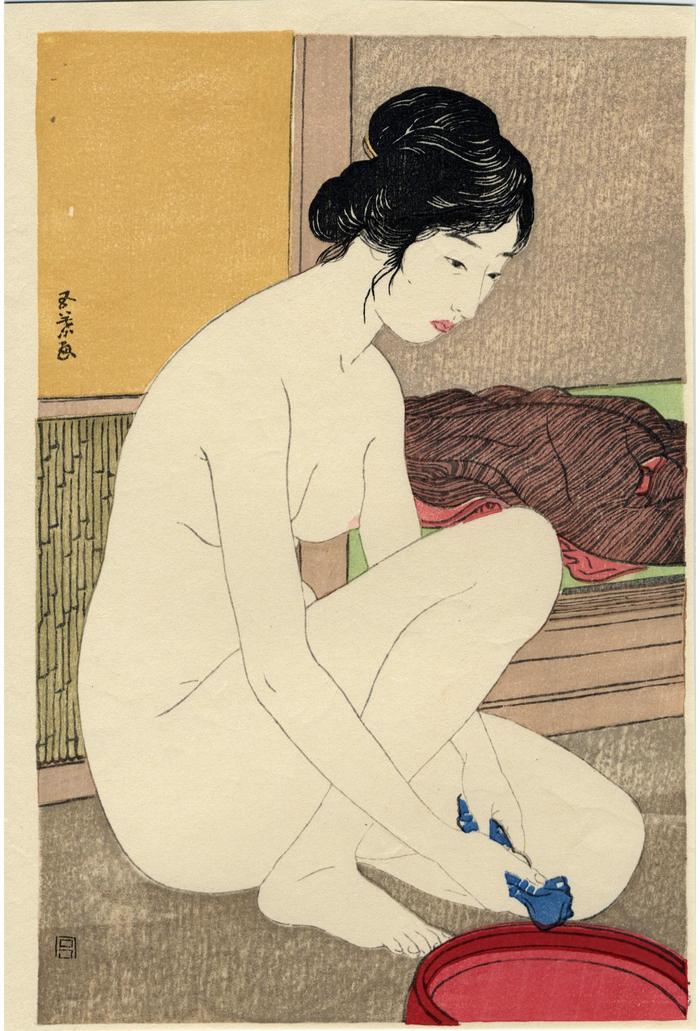Hashiguchi Goyō (橋口五葉) (artist 1880 – 1921)
Woman at the bath (Yokujō no onna - 浴場の女)
1950s
8.5 in x 12.5 in (Overall dimensions) Japanese color woodblock print
Signed: Goyō ga (五葉画)
Museum of Fine Arts, Boston - Signed and sealed Goyō and dated Taishō 4 (大正四)
Minneapolis Institute of Arts
Library of Congress
Harvard Art Museums - in black and white
Compares 1915 originals to 1950s recarves
Hagi Uragami Museum of Art
National Museum of Asian Art
Centre Céramique de Maastricht
National Museum of Modern Art, Tokyo
Dayton Institute of Art Originally published 1915, this example is not from original blocks and was pulled around 1950s. In the original printing the date seal corresponding to 1915 is seen just to the right of the signature, but not in this example.
A nude kneeling girl holding a blue cloth looks reflectively ahead.
Merritt wrote in her Modern Japanese Woodblock Prints: The Early Years (pp. 44-46): Goyō had studied yōga but had attracted Watanabe's attention with a prize-winning ukiyo-e-style poster and with an article on Utamaro in an art magazine. Watanabe asked Goyō to make a design from which prints could be produced. Goyō accepted Watanabe's invitation and drew a nude stooping by a round tub and wringing water from a small towel. In October 1915, in collaboration with Goyō, and under Watanabe's supervision, the carver Takan Shichinosuke made the numerous blocks which were required for the print. An artisan printer then printed he blocks to produce Bathing (Yuami). To Watanabe this shin-hanga was his dream come true."
Note that here the term yōga means Western-style.
Donald Jenkins, in his essay in The New Wave, the book about the Robert O. Muller collection, wrote on page 20: "Nineteen-fifteen... is generally conceded to be an important one in the history of modern Japanese prints. It was in that year that Watanabe Shōzaburō commissioned Goyō to design his Nude after the bath, and in so doing set out on the path that would soon make him the leading advocate of shin hanga - a term that, incidentally, Watanabe himself coined."
****
Illustrated:
1) in a full-page color reproduction in Ukiyo-e to Shin Hanga: The Art of Japanese Woodblock Prints in a chapter by Haruo Matsuoka, p. 216.
2) in Ukiyoe Museums in Japan (Nihon no ukiyoe bijutsukan - 日本の浮世絵美術館), vol. 3, p. 47. Their example is from the collection of the National Museum of Modern Art, Tokyo.
3) in Ukiyo-e to Shin hanga: The Art of Japanese Woodblock Prints, Mallard Press, 1990, p. 216.
4) in color in The Female Image: 20th century prints of Japanese beauties, Abe Publisher, 2000, #2, p. 39. (The original version.)
5) in color in Seven Masters: 20th-Century Japanese Woodblock Prints from The Wells Collection, Minneapolis Institute of Arts, 2015, p. 39.
6) in color in 原色浮世絵大百科事典 (Genshoku Ukiyoe Daihyakka Jiten), vol. 3, p. 45, #158.
modern prints (shin hanga - 新版画) (genre)
beautiful woman picture (bijin-ga - 美人画) (genre)
